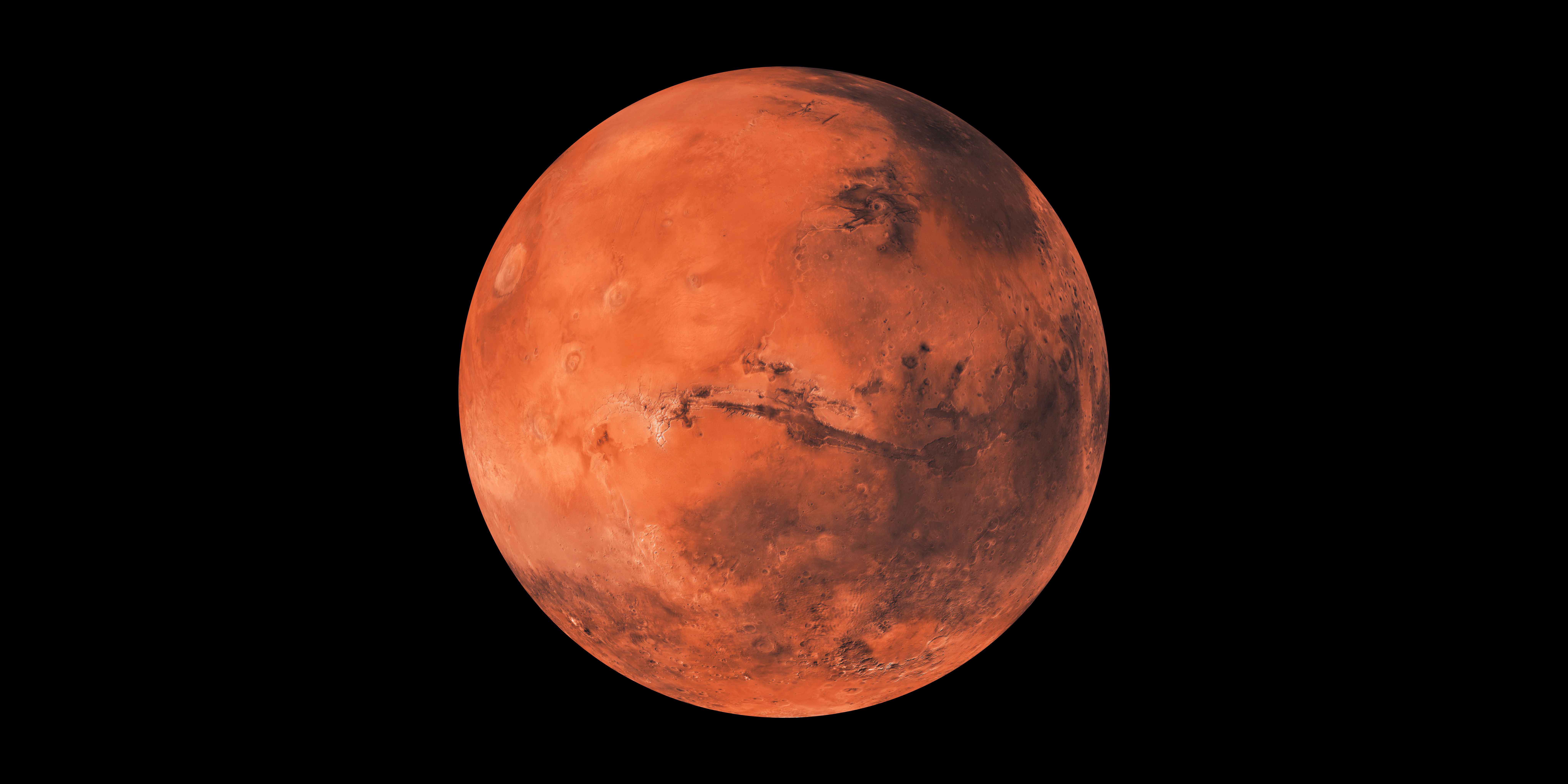UV Radiation Impact on Raman and Infrared Signals: A Look at the Surface of Mars
A recent study in Icarus examined how Mars’ ultraviolet radiation affects mineral composition on the planet’s surface.
According to a recent study published in Icarus, the planet’s ultraviolet (UV) radiation impacts the mineral composition on the planet’s surface (1).
Ongoing Martian exploration missions that NASA’s Perseverance rover is conducting is providing scientists with valuable information as NASA and other space exploration organizations look to send manned missions to Mars. NASA’s Perseverance rover, in particular, is providing critical information about the Martian surface. The Perseverance rover was initially launched in July 2020 (2). The rover was equipped with the necessary technology to collect rock and mineral samples, helping scientists learn more about the composition of the planet’s surface (2,3).
Mars red planet black background | Image Credit: © Martin - stock.adobe.com

This new study was conducted by researchers from Purdue University, Sorbonne Université, and Université de Paris. The study explored how Mars' harsh environment, particularly its ultraviolet (UV) radiation, affects the composition of minerals on the planet’s surface (1). The results showed that hydrated minerals like sulfates, phosphates, and carbonates undergo significant alterations when exposed to UV radiation, raising important questions about the implications of such exposure for ongoing Martian exploration missions (1).
The study was led by C. Royer and S. Bernard. Their experimental procedure exposed various minerals to UV radiation in a Martian chamber. By simulating temperatures relevant to Mars' surface, the team examined how these minerals react over time (1). Their findings highlighted critical concerns for the study of Martian geology and the planet's paleoenvironmental conditions, revealing that the continuous exposure to UV radiation could substantially alter the surface minerals Perseverance and other rovers aim to analyze (1).
Mars, unlike Earth, lacks a thick atmosphere and magnetic field to shield its surface from ionizing and non-ionizing radiation, including UV rays. As a result, the planet's surface is bombarded by intense radiation, which may significantly alter its mineralogical landscape. Sulfates, phosphates, and carbonates—minerals commonly found on Mars and critical to understanding its past water activity—are particularly susceptible to changes caused by this radiation (1).
The research team found that UV exposure leads to a marked alteration in the Raman and infrared (IR) signals of these minerals (1). Specifically, the Raman signals showed a strong decrease relative to the background, while the IR signals were also significantly attenuated (1). The team also observed a strong increase in luminescence signals, which they attributed to an increasing concentration of electronic defects within the minerals (1).
These changes are crucial for the scientific community to consider when interpreting the data collected by Mars missions. Since many of the mineral samples examined by rovers like Perseverance may have been exposed to UV radiation for extended periods, their chemical signatures could differ from what would be expected from pristine, unaltered minerals (1).
However, despite the alterations caused by UV radiation, the study offers a silver lining. The Raman spectra of the UV-exposed sulfates, phosphates, and carbonates still exhibited the main spectral features seen in their unaltered counterparts, such as the peak attributed to the v1 symmetric stretching modes (1). This indicates that, although the minerals are altered, their fundamental chemical structures remain intact to a certain degree.
As the Perseverance rover continues its mission of collecting samples, these findings will guide scientists in interpreting the mineralogical data from Mars, ensuring that they factor in the significant impact of UV radiation exposure (3).
Ultimately, understanding the effects of its environment on surface materials will be key to unraveling the mysteries of the Red Planet and sending astronauts to Mars.
References
- Royer, C.; Bernard, S.; Beyssac, O. Impact of UV Radiation on the Raman and Infrared Spectral Signatures of Sulfates, Phosphates and Carbonates: Implications for Mars Exploration. Icarus 2024, 410, 115894. DOI: 10.1016/j.icarus.2023.115894
- Wetzel, W. How NASA’s Perseverance Rover is Using Spectroscopy to Uncover the Secrets of Mars. Spectroscopy. Available at: https://www.spectroscopyonline.com/view/how-nasa-s-perseverance-rover-is-using-spectroscopy-to-uncover-the-secrets-of-mars (accessed 2024-10-07).
- Workman, Jr., J. Mars Rover Uses Spectroscopy to Detect Diverse Organic-Mineral Associations in Jezero Crater. Spectroscopy. Available at: https://www.spectroscopyonline.com/view/mars-rover-uses-spectroscopy-to-detect-diverse-organic-mineral-associations-in-jezero-crater (accessed 2024-10-07).
AI Boosts SERS for Next Generation Biomedical Breakthroughs
July 2nd 2025Researchers from Shanghai Jiao Tong University are harnessing artificial intelligence to elevate surface-enhanced Raman spectroscopy (SERS) for highly sensitive, multiplexed biomedical analysis, enabling faster diagnostics, imaging, and personalized treatments.
Artificial Intelligence Accelerates Molecular Vibration Analysis, Study Finds
July 1st 2025A new review led by researchers from MIT and Oak Ridge National Laboratory outlines how artificial intelligence (AI) is transforming the study of molecular vibrations and phonons, making spectroscopic analysis faster, more accurate, and more accessible.
Toward a Generalizable Model of Diffuse Reflectance in Particulate Systems
June 30th 2025This tutorial examines the modeling of diffuse reflectance (DR) in complex particulate samples, such as powders and granular solids. Traditional theoretical frameworks like empirical absorbance, Kubelka-Munk, radiative transfer theory (RTT), and the Hapke model are presented in standard and matrix notation where applicable. Their advantages and limitations are highlighted, particularly for heterogeneous particle size distributions and real-world variations in the optical properties of particulate samples. Hybrid and emerging computational strategies, including Monte Carlo methods, full-wave numerical solvers, and machine learning (ML) models, are evaluated for their potential to produce more generalizable prediction models.